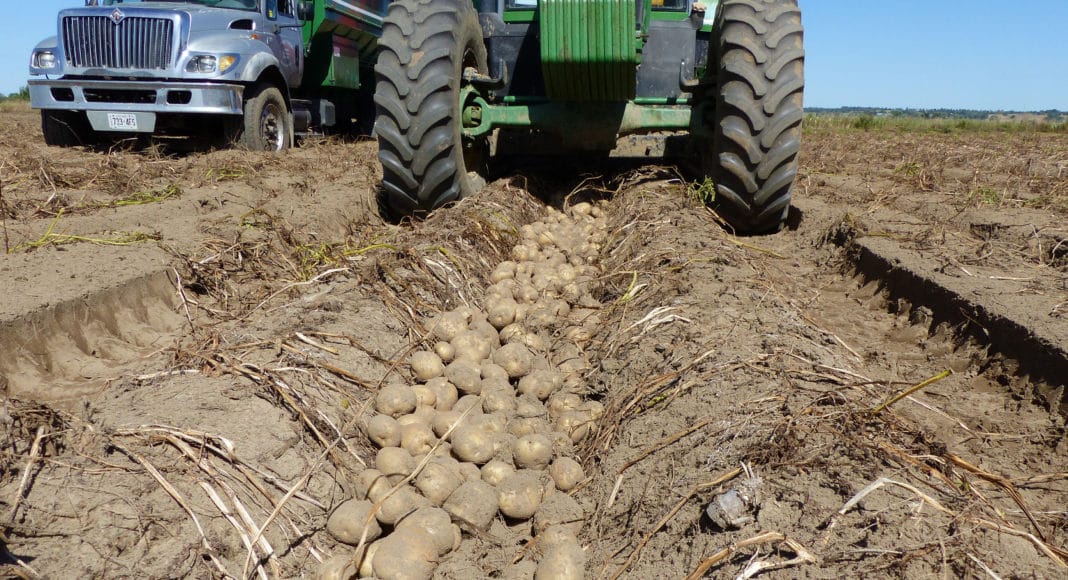Harvest management is, in large part, bruise management. Bruising affects tuber quality significantly. Bruised tubers are easily invaded by soft rot, Fusarium dry rot and Pythium rot, which can cause serious economic losses in storage. To harvest potatoes with minimum tuber damage, growers need to implement digging, handling and storage management practices that maintain crop quality for as long as possible following harvest.
Assuming all harvest and handling equipment are mechanically ready to harvest the crop with minimum bruising, there are several tips in this checklist to preserve the quality of potatoes during harvest:
- Sugar Testing — Collecting tuber samples two to three times a week apart leading up to targeted top kill and measuring sucrose and glucose will give you an idea of chemical maturity. Knowing the sugar levels can help you decide on topkill timing, how to manage the storage environment and how soon and how long they might fry.
- Timely Vine Killing — Killing the vines when tubers are mature reduces the total vine mass moving through the harvester. This allows for an easier separation of tubers from vines.
- Timely Harvest — Potatoes for long term storage should not be harvested until the vines have been dead for at least 14 days to allow for full skin set.
- Do test digs on your fields to check the conditions of the crop. If you find problem areas, you can make timely decisions that will help you to keep the potatoes safely stored for several months.
- Do not harvest potatoes from low, poorly drained areas of a field. It is highly probable that tubers from areas where water accumulated will develop soft rot, Pythium leak, pink rot or pink eye. In addition, enlarged lenticels, a common problem of tubers from wet areas, predispose tubers to soft rot.
- Use a roller to minimize soil cracking to reduce both greening and the risk of tuber blight.
- Monitor soil moisture — Optimal harvest conditions are at 60 to 65 per cent available soil moisture. Excessively wet soil remains caked on tubers and decreases the efficacy of CIPC applied in storage.
- Monitor tuber pulp temperature — The optimal pulp temperature for harvest is from 110 C to 160 C. Proper pulp temperature is critical; tubers are very sensitive to bruising when the pulp temperature is below 70 C. Tubers become very susceptible to soft rot and Pythium leak if pulp temperatures are above 180 C. Pulp temperatures of 210 C increase the risk of pink rot if inoculum is present.
- Harvest when day temperatures are not too warm. Tuber infections develop very rapidly at high temperatures and spread easily in storage. If potatoes are harvested during hot and humid weather (above 270 C) and cooled slowly, the likelihood of storage rot is increased. Dig early in the morning if warm weather is in the forecast.
10. Monitor tuber hydration — This influences the amount and type of bruising.
a. Overhydrated tubers dug from wet soil are highly sensitive to shatter bruise especially when the pulp is below 70 C. In addition, tubers harvested from cold, wet soils are more difficult to cure and more prone to breakdown in storage.
b. Slightly dehydrated tubers dug from dry soil are highly sensitive to blackspot bruise. An intermediate level of hydration results in the least amount of tuber bruising. Where irrigation is available, dry soil should be watered to prevent tuber dehydration and high incidence of blackspot bruise.
- If soil clods are a problem, irrigate at least one week before digging to soften clods and rehydrate tubers.
- Adjust harvester chain conveyor speed in relation to ground speed to maintain a full, uniform flow of potatoes on each conveyor.
- Install padding on the harvester at points where potatoes may be bruised.
- Use Bruise Detection Devices — The volume of soil and tubers moving through the harvester should be held at capacity at all points of the machine. Bruise detection devices can indicate where the tubers are being bruised.
- Make sure all employees are properly trained and aware of bruise reduction strategies. Harvester operators must be on the lookout for equipment problems that may be damaging tubers.
- Ideally, growers should implement a bruise management program that includes all aspects of potato production from planting through to harvest.
Related Articles
Checklist for a Successful Harvest of the Storage Crop











